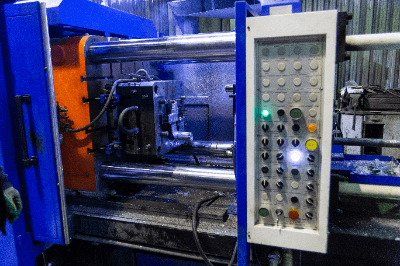What Is a Die Casting Machine?

A die casting machine is a piece of equipment that melts a metal or alloy at high speed and pours it into a mold for casting.
Die casting machines can mass-produce products of the same shape with high precision, thus reducing the workload of workers. They are also effective when using low-melting-point metals such as aluminum and zinc, since low-melting-point metals are easy to melt and pour into the die.
However, it is difficult to use die casting machines for metals with high melting points, necessitating the use of other casting methods. Another advantage of die casting machine casting is that the surface of the product is very smooth, so the polishing process can be omitted.
Omission of the polishing process leads to reductions in product manufacturing time and cost.
Uses of Die Casting Machines
Die casting machines are used in a variety of industries. Specifically, they are used in the manufacture of automotive parts, electronic devices, and construction materials. Recently, die casting machines have been developed that use environmentally friendly materials to reduce product waste and increase sustainability.
1. Automotive Parts
In automotive, aluminum is used to manufacture a wide variety of parts, from engine blocks, cylinder heads, and other components to emblems, door handles, and other small decorative items. In particular, the use of lightweight and highly rigid aluminum alloys can improve vehicle fuel efficiency and safety.
2. Electronics
In electronics, aluminum alloys are used to manufacture metal parts used in smartphones, tablet devices, and digital cameras. Examples include camera lens holders, shutter buttons, and aluminum frames for smartphones.
3. Building Materials
In building materials, die-casting machines are used to manufacture small to large and complex shaped parts such as door knobs, handles, shutter hinges, and curtain walls and facade panels that decorate the exterior of buildings.
Principle of Die Casting Machines
The principle of making a product with a die casting machine consists of creating a mold that matches the shape and pouring liquid metal into it. Die casting machines use pistons that utilize hydraulic pressure, which must be above a certain level.
Liquid metal such as aluminum alloy, called molten metal, is poured into the die connected to the die casting machine. Since the die into which molten metal is poured is subject to internal pressure, care must be taken to ensure that the die is not tightly sealed or the molten metal may leak from the gaps in the die.
For example, a die casting machine during casting will hold the mold under high pressure. When the liquid metal poured into the mold is cooled, a hardened product conforming to the shape of the mold is completed.
Types of Die Casting Machines
Die casting machines are classified into two types:
1. Hot Chamber Type
The hot chamber system is named after the injection section, which injects molten metal, and the molten metal storage furnace, which are integrated into a single unit, and the injection section is constantly heated. Since the injection part is always heated, it is used for casting materials with low melting temperatures from the viewpoint of safety and durability of parts. The major advantage is that molten metal can be injected efficiently.
2. Cold Chamber Method
The cold chamber system is named after the fact that the injection section, where molten metal is injected, and the molten metal storage channel are separated and the injection section is not heated at all times. Since the molten-metal storage furnace is independent, it is used for casting materials with high melting temperatures; molten-metal injection is required for each product, and the production time tends to be long.
Other Information on Die Casting Machines
Die Casting Machine Molds
Die casting machine molds are mainly responsible for determining the shape and changing the temperature.
1. Shape Determination
Since products are manufactured according to the die, the die determines the general and detailed shape of the product, as well as small grooves and holes. The accuracy of the mold’s shape is an important point because it directly affects the quality of the product.
The position of the gate for pouring molten metal and the flow of molten metal in the mold are determined according to the shape of the product and the number of products to be manufactured at one time. If the mold is in the way and the product cannot be taken out, a mechanism is added to move the mold at an angle or a hydraulic cylinder is pushed out to take the product out.
2. Temperature Change
Die-cast products are manufactured by cooling and solidifying molten metal. The die, which determines the quality of the product, is a very important component of the die casting machine. In addition, the creation of a die takes months and the cost of creating a die is a large part of the manufacturing process.
If a die fails or is damaged during mass production, production must be halted. It is important to note that along with a significant reduction in production capacity, there are additional costs associated with mold maintenance.